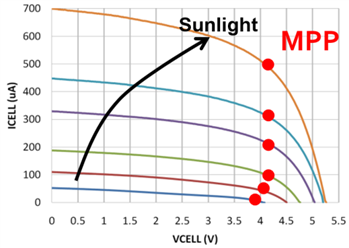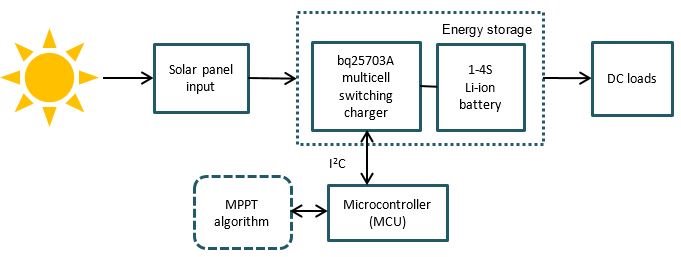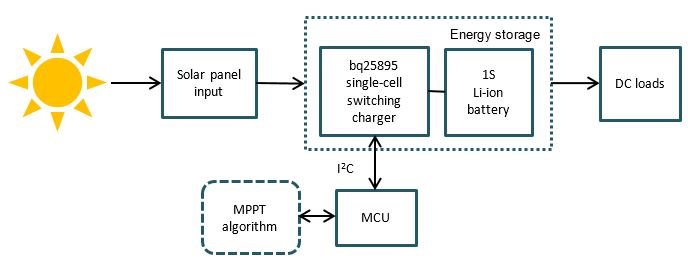SSZT711 May 2018 BQ25703A , BQ25895
As solar-powered devices become more portable and interconnected, rechargeable batteries eliminate the need for AC adapter input power and take advantage of the abundant energy from the sun.
For example, devices such as e-bikes and Internet Protocol network cameras spend most of their time outside and away from power outlets, making solar charging critical for system operation. Likewise, solar-charging technology enables the collection and storage of energy in power banks during remote activities such as hiking, where the power grid is beyond reach.
Typically, a single solar cell produces about 0.7V. Consisting of several stacked cells, a panel is capable of supplying a wide range of voltages and provides input power for the charging system. Due to inconsistencies in the amount of sunlight shining on a panel, temperature variations and the high impedance of the cell stack, solar panels require operation at a maximum point to output the greatest power with the highest efficiency.
When a system must handle high source impedance and lighting variations, using a charger that steps down (bucks) or steps up (boosts) the voltages offers the best solution for solar applications. TI’s bq25703A multicell buck-boost charger transitions between buck mode and boost mode based on the battery’s charge requirements, thus successfully managing any solar voltage input. In some simpler, low-power applications, the bq25895 single-cell buck charger is an appropriate choice for solar battery charging. Both the bq25703A and bq25895 use I2C functionality to determine the maximum power point (MPP) of the system and efficiently charge the battery.
Charging for Mid/high-power Solar Applications
Although many chargers on the market only provide buck mode, the bq25703A is able to step down or step up the input voltage to the battery. Operating at an input voltage range of 3.5V to 24V, this charger is compatible with solar panels that typically have an open circuit voltage of up to 24V. In order to efficiently use sunlight as a source of power for solar charging applications, the charger implements MPP tracking (MPPT) using input voltage regulation to achieve maximum output power.
 Figure 1 IV Curve of a Solar Cell
Figure 1 IV Curve of a Solar CellUsing the adjustable voltage dynamic power-management loop, , the charger decreases the charge current when the voltage falls below the input voltage setting. With this dynamic power-management feature, the bq25703A can therefore implement MPPT for solar applications.
When the solar panel powers the input, an MPPT algorithm adjusts the input voltage to the MPP voltage and clamps the input current to extract the maximum output power from the panel. Figure 2 illustrates a solar battery charging implementation using the bq25703A.
 Figure 2 Solar Charging with the bq25703A
Figure 2 Solar Charging with the bq25703AWith buck, boost and buck-boost capabilities, this charger can take a solar power input voltage that is lower or higher than what the battery requires and step up or step down to charge a one- to four-cell battery. However, if the design requires lower-power solar battery charging, the bq25895 single-cell buck mode switching charger implements an algorithm to extract an MPP.
Charging for Low-power Solar Applications
The bq25895 provides a simple, integrated solution to solar battery charging for low-power applications. With an operating input range of 3.9V to 14V, the bq25895 is compatible with solar panels that have an open circuit voltage of up to 12V, charging a single-cell lithium-ion (Li-ion) or lithium-polymer battery. This single-cell charger implements MPPT using the charger’s integrated analog-to-digital converter (ADC).
After the initialization of parameters, the algorithm increases from its lower limit of 65% of the open-circuit voltage, and the ADC measures the charge current. By constantly monitoring for the maximum charging current, the algorithm can determine the MPP as it changes with varying amounts of sunlight.
Figure 3 shows the solar charging process using the bq25895. Although the device only offers bucking capabilities, the charger possesses the MPPT algorithm necessary for using solar input power and succeeds in low-power situations when boosting the input is atypical.
 Figure 3 Solar Charging with the bq25895
Figure 3 Solar Charging with the bq25895Conclusion
As the portability of technology continues to grow, devices in the market are quickly adopting rechargeable batteries to satisfy their power needs. For outdoor applications where plugs are not readily available, energy from the sun can provide the input power needed for the system. However, because sunlight intensity varies, the charger must optimize the solar input in order to efficiently output maximum power.